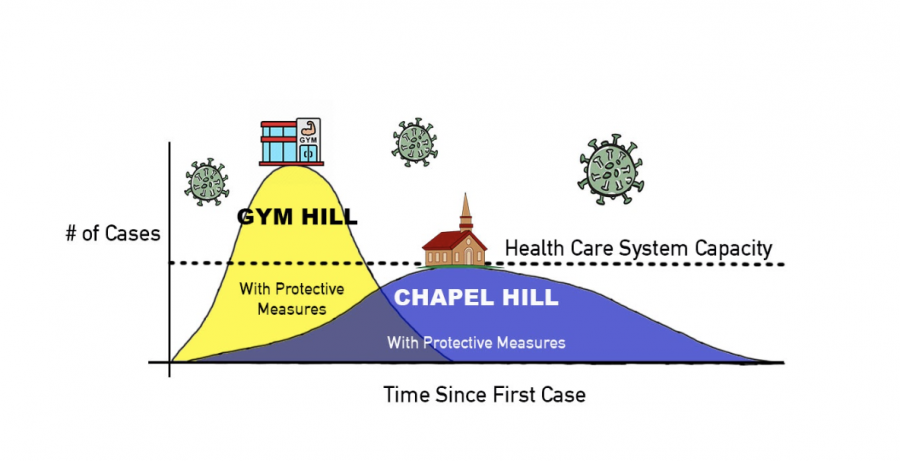We all know the walk up gym hill can be long and exhausting. Through the use of social distancing protocols, washing and sanitizing your hands frequently, and wearing a mask, we can all help this pandemic feel mores like the less steep, manageable walk to chapel instead. Graphic Courtesy of Keigan McCullagh.
What does it really mean to “flatten the curve”?
Since the beginning of the COVID-19 outbreak, scientists and leaders have been urging us to “flatten the curve,” referring to a graph that shows two projections of how the pandemic could unfold. The graph plots the number of cases over time, and the two curves represent that number with and without protective measures. Additionally, there is a line showing the maximum number of cases the American healthcare system can handle. The “without protective measures” curve skyrockets well above the line, while the “with protective measures” curve stays below it.
To “flatten the curve” is, in essence, to slow the spread of the virus. It is this motive that is driving the social distancing guidelines, shelter-in-place orders, business closures, and other regulations put in place by local and state governments throughout this pandemic. The only way for the situation to get better is to dramatically limit the ability of the virus to spread, making social distancing and staying home whenever possible in everyone’s best interest.
Many Webb students are practicing these protocols, spending most of the day at home while taking classes on Zoom. Webb is just one of all of the public and private schools that have closed as a result of the pandemic, all in an effort to stop transmission and flatten the curve.
“To me ‘flattening the curve’ means that every healthy person does whatever possible to stay healthy and every sick person does whatever possible to not spread the disease,” Maya Jaffe (‘20) said. “So even though I’m completely healthy, I’m staying home 100% of the time and not coming into contact with anyone outside of my household.”
The decision to close Webb’s campus was ultimately made due to the rapid spread of COVID-19. Sarah Lantz, Dean of VWS, says the school recognized that it would be very difficult to ensure the safety of the entire campus.
“I think that the final decision was because it was beginning to spread, and knowing how dormitories can be places where things are spread very quickly” said Dean Lantz. “And because when you have 265 boarding students… it’s hard to restrict people’s access to other people off campus.”
The faculty and staff that remain on Webb’s campus are also practicing social distancing guidelines, many staff members working staggered hours to avoid close contact with others, and classrooms where teachers are teaching their online classes are being sanitized daily.
Many state’s governors have issued stay-at-home orders, California being the first to be placed under such regulations. Since that order, issued by Governor Gavin Newson on March 19, the number of cases of COVID-19 have fallen far below the number projected in mid-March. California has not and should not see a shortage of ICU beds, according to a projection by the University of Washington’s Institute for Health Metrics and Evaluation (IHME). The same projection predicts that California will reach peak resource use on April 17. However, California residents must continue social distancing for at least the next month.
Additionally, social distancing is the best way to ensure the medical industry is able to sufficiently serve everyone, which it has not been able to do. Hotels are being converted into hospitals, masks and ventilators being rationed, and potentially infected people are going without tests. The inability of health care professionals to serve everyone adequately puts us all at risk.The CDC urges everyone to practice social distancing. That recommendation means avoiding mass gatherings or congregations and staying six feet away from anyone outside your household. Avoid unnecessary interaction altogether. The best way to support doctors and nurses on the front lines, elderly and immunocompromised people at risk, and each other is to stay home.
